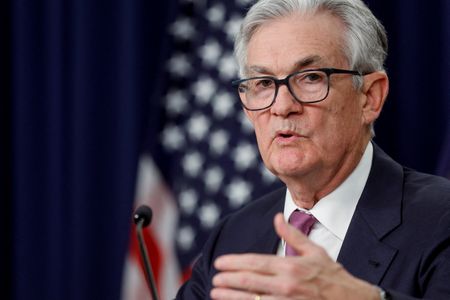By Ann Saphir
WASHINGTON (Reuters) – Financial markets this week latched on to what U.S. Federal Reserve Chair Jerome Powell called “most welcome” disinflation, betting it signals the central bank’s war on high inflation is nearing an end.
Powell in fact used the word 15 times during his 45-minute press conference Wednesday – an explosion of attention after just one mention in other press conferences going back to the start of Fed rate hikes last March.
But what, exactly, is disinflation, and why is it welcome?
INFLATION
To understand disinflation, it is helpful to first understand what central bankers mean by inflation: increases in prices across a broad range of goods and services.
Central banks globally tend to target 2% annual inflation (the Fed formally adopted a 2% target in 2012). That doesn’t mean that the price of everything rises 2% – some items may increase more sharply, and others might even drop in price.
But if overall a typical household is consuming about the same as last year and paying just 2% more for it, that’s thought to be low enough that they will not have to worry much about it in their day-to-day planning, but high enough to give central bankers wiggle room to fight economic downturns with interest-rate cuts.
When inflation runs higher than that, it is a big problem for the economy, not just because people and businesses hate paying more for everyday items, but because it can turn into a vicious cycle. Workers find that with higher prices, their paychecks do not go as far, so they demand higher wages, which businesses pay for by raising their prices, which then further strains paychecks.
To head that off, the central bank raises interest rates, which makes borrowing more expensive, and restrains spending and, eventually, inflation. That is what the Fed — and most central banks around the world – are doing right now.
DISINFLATION = SLOWING INFLATION
Currently inflation by the Fed’s preferred measure – the personal consumption expenditures (PCE) price index – is running at about 5%. That is far above the Fed’s 2% target, though down from its peak of 7% last June.
A drop in the rate of inflation like that is called disinflation. Powell on Wednesday called it a “gratifying” progress and one sign that the Fed’s sharp interest-rate increases are working as they should.
(Prices still rising, but more slowly https://www.reuters.com/graphics/USA-FED/lgvdknnbxpo/chart.png)
DISINFLATION ISN’T EVERYWHERE
To be sure, some prices are still soaring. Eggs rose 254% last month, annualized, as avian flu disrupted the global supply of chickens. Jewelry rose 54%.
But in general the price of goods is on the decline – musical instruments fell 12% annualized in January, compared with December, a breakdown published by the Dallas Fed shows; used cars fell 27%. Goods make up about a quarter of the Fed’s preferred inflation gauge.
The price of housing, which makes up about another quarter of the PCE price index, is still on the rise, but the Fed’s higher interest rates are hitting demand, and people signing new leases are getting better and better deals. Economists expect those softer new leases to start showing up in official measures in coming months – another part of the “good story” of disinflation, Powell said.
Still, disinflation in what the Fed calls core services excluding housing – accounting for just over half of overall inflation – has not yet begun, Powell said, noting it is running at a steady 4%, putting a floor under the overall rate of disinflation. Airline tickets, for example, more than doubled in January.
This part of inflation is driven largely by wages, though Powell said it is not yet clear how much the labor market will need to soften – and how many people may need to lose their jobs – for disinflation to take hold there.
Some economists, like Nobel laureate Joseph Stiglitz, argue U.S. inflation is supply-side driven and say that the Fed’s rate hikes will push a fragile global economy into a recession that would affect the world’s most vulnerable.
Many economists are forecasting a recession this year, along with a rise in the unemployment rate, now at 3.5%, though how sharp either would be remains a question.
“My base case is that the economy can return to 2 percent inflation without a really significant downturn or a really big increase in unemployment,” Powell said Wednesday. “It is a good thing that the disinflation that we have seen so far has not come at the expense of a weaker labor market.”
(U.S. goods prices are leading disinflation https://www.reuters.com/graphics/USA-FED/gdpzqddlyvw/chart.png)
DISINFLATION HASN’T ALWAYS BEEN WELCOME
Disinflation is not always a positive development.
Former Fed Chair Alan Greenspan famously warned in 2003 that with inflation low, at 1.8%, “substantial further disinflation would be an unwelcome development.” Soon after the Fed cut rates to stop it from becoming what could become an even bigger problem – deflation, or an outright decline in overall prices, which haunted Japan for decades.
Falling prices tend to sap economic strength, as households for instance put off purchases knowing they could get a better deal if they wait, which eats at spending and can in turn deepen price declines further.
But for today, with inflation high, it’s what the Fed wants. “We can now say, I think, for the first time, that the disinflationary process has started,” Powell said Wednesday. “It’s most welcome to be able to say that we are now in disinflation.”
(Reporting by Ann Saphir; Editing by Dan Burns and Aurora Ellis)

